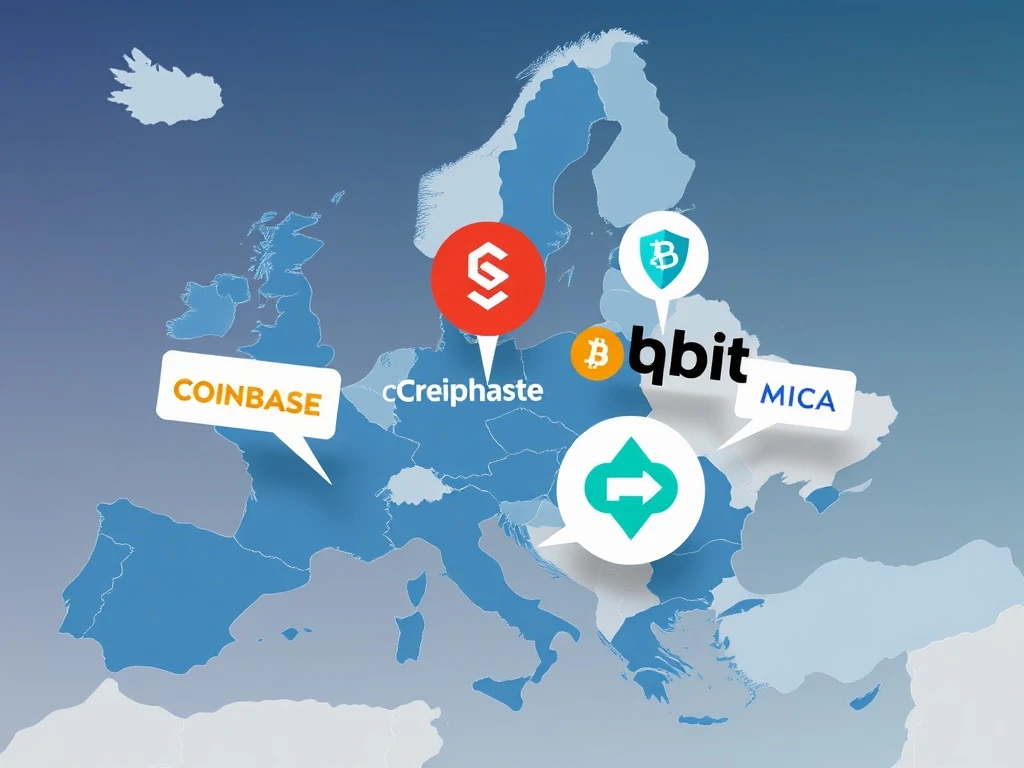European Crypto Market: Unleashing an Intense Boom as Exchanges Vie for Dominance

The cryptocurrency world is buzzing, and all eyes are turning towards Europe. A significant shift is underway as major players race to establish a foothold in the region, transforming the European crypto market into a hotbed of activity. This isn’t just about expansion; it’s about strategic positioning in a newly regulated landscape that promises clarity and growth.
Why the European Crypto Market is Attracting Giants
Europe is fast becoming a prime destination for global crypto exchanges. The primary catalyst for this influx is the Markets in Crypto-Assets (MiCA) regulation. This comprehensive framework, four years in the making, provides a clear and unified set of rules across the European Economic Area (EEA). This regulatory clarity offers a distinct advantage over other jurisdictions still grappling with rudimentary frameworks, such as the United States.
For exchanges, MiCA means:
- Legal Clarity: A predictable environment for long-term planning and operations.
- Pan-European Passport: A single license allows operations across 30 EEA countries, streamlining expansion.
- Institutional Access: High consumer standards, on par with traditional finance, open doors to institutional clients for derivatives and portfolio management.
- Local Integration: Access to euro-based pairs and local payment rails, improving user experience.
Major players like OKX, Coinbase, Bybit, and Crypto.com have already secured licenses under MiCA, signaling their commitment to this regulated environment. Erald Ghoos, CEO of OKX Europe, highlighted that MiCA offers his exchange a “clear regulatory framework that offers legal clarity and fosters long-term planning.” This strategic pivot is already showing results, with Konstantins Vasilenko of Paybis reporting a 70% increase in trading volumes from EU customers in Q1 2025 post-MiCA implementation, likely driven by increased institutional involvement.
Navigating the Landscape of MiCA Regulation
MiCA is more than just a set of rules; it’s a paradigm shift for the industry in Europe. Its seven titles cover critical areas, including platform regulations, token issuance, and market abuse. While some initially raised concerns about increased surveillance, executives now largely view MiCA as a foundation for stability and trust. This robust framework is setting Europe apart, with regulators already discussing a “MiCA 2.0” to address further gaps.
The regulation ensures that all crypto exchanges Europe operate by the same standards, fostering a level playing field. Lukas Enzersdorfer-Konrad, Deputy CEO of Bitpanda, believes MiCA is already having a positive effect, even in its early stages. This regulatory rigor is designed to protect consumers and attract more sophisticated investors, laying the groundwork for sustainable growth.
Challenges and Consolidation for Crypto Exchanges Europe
While MiCA offers significant advantages, operating under its umbrella is not without challenges. A spokesperson for Bybit noted that MiCA demands “strict controls around investor protection, capital requirements, operational transparency, and Anti-Money Laundering compliance.” These requirements necessitate significant structural changes, which can be difficult to implement “without compromising user experience.”
For exchanges like OKX, balancing localization with global infrastructure is a key hurdle. Erald Ghoos explained the challenge of “balancing localization (language, customer service, financial standards) with maintaining global infrastructure and scalability.” Providing localized products for each market requires time and meticulous effort.
Many executives anticipate a consolidation within the crypto market competition in Europe. The Bybit spokesperson believes MiCA will “separate serious market players from unlicensed actors.” Smaller exchanges may struggle with the cost and complexity of meeting MiCA standards, favoring larger, tech-advanced entities that can leverage scale and resources. This trend could see major players like OKX, Coinbase, and Crypto.com further solidify their positions, while smaller, less prepared platforms face increased pressure.
Boosting EU Crypto Adoption: A Long-Term Vision
Despite the influx of major exchanges, Europe currently exhibits lower EU crypto adoption rates compared to many developing countries. This is often attributed to the region’s well-established traditional finance systems and stable currencies. However, industry leaders see MiCA as a turning point.
Lukas Enzersdorfer-Konrad of Bitpanda emphasizes that Europe’s adoption is focused on “trust and regulation over speed,” indicating a commitment to long-term, sustainable growth. The increased trust stemming from clear regulations is expected to drive demand and confidence. As institutions perceive crypto as a safer investment with traditional safeguards, their increased involvement could lead to broader retail participation. As Enzersdorfer-Konrad put it, “Clear rules increase trust, and trust drives adoption. Over time, this will unlock broader retail participation and allow institutions to move with confidence.”
The Future of Crypto Market Competition in Europe
The stage is set for an intriguing period of crypto market competition in Europe. With major global exchanges now operating under a unified regulatory framework, the dynamics are shifting. This new era promises a more mature and secure environment, which could ultimately boost overall EU crypto adoption. While a “turf war” among large new entrants and the potential consolidation of smaller players are on the horizon, the ultimate beneficiary may be the European consumer, who will gain access to more secure and compliant crypto services.
A New Era of Stability and Growth
The transformation of the European crypto market is undeniable. MiCA regulation has not only attracted major exchanges but has also set a precedent for regulatory clarity globally. While challenges persist, the long-term outlook for the European crypto ecosystem appears robust, driven by increased trust, institutional participation, and fierce, yet regulated, competition. This evolving landscape is poised to redefine Europe’s role in the global crypto economy.








